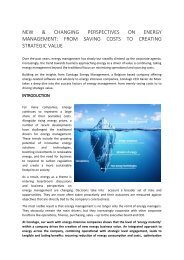Accurate Allocation of energy in production processes - the importance of using metamodels
Many companies struggle with correctly monitoring, allocating and distributing direct and indirect energy consumption over all internal and external customers, users or products. In this age of rising commodity costs and additional attention to sustainability, the advantages of adequately allocating energy are nonetheless substantial: 1. Real-time mapping of energy throughout process flows makes it easier to detect deviations in energy conversions during production processes, find the root causes and reduce losses. 2. Using exact and objective keys for allocating energy consumption speeds up periodic P&L and CSR reporting and makes for more accurate reports. 3. Continuous, real-time distribution of energy cost among users increases transparency and raises awareness with them. Although most companies already struggle with integrating correct data from metered equipment, this is only the first - albeit important - step. The crux is fully understanding the nature and efficiency of energy conversions processes; energy inflows and outflows to different customers; fixed and variable costs and corporate structures. By using metamodels - designed for and maintained by energy managers - all this information is added to the initial metered data and processed in such a way that any change from an energy point of view instantly leads to adjustments in the energy allocation. This white paper reviews emerging trends and challenges in energy allocation and examines the working and benefits of using specific metamodels at the level of energy management software.
Many companies struggle with correctly monitoring, allocating and distributing
direct and indirect energy consumption over all internal and external customers,
users or products. In this age of rising commodity costs and additional
attention to sustainability, the advantages of adequately allocating energy are
nonetheless substantial:
1. Real-time mapping of energy throughout process flows makes it easier
to detect deviations in energy conversions during production processes,
find the root causes and reduce losses.
2. Using exact and objective keys for allocating energy consumption
speeds up periodic P&L and CSR reporting and makes for more accurate
reports.
3. Continuous, real-time distribution of energy cost among users increases
transparency and raises awareness with them.
Although most companies already struggle with integrating correct data from
metered equipment, this is only the first - albeit important - step. The crux is
fully understanding the nature and efficiency of energy conversions processes;
energy inflows and outflows to different customers; fixed and variable costs
and corporate structures. By using metamodels - designed for and maintained
by energy managers - all this information is added to the initial metered data
and processed in such a way that any change from an energy point of view
instantly leads to adjustments in the energy allocation.
This white paper reviews emerging trends and challenges in energy allocation
and examines the working and benefits of using specific metamodels at the
level of energy management software.
Create successful ePaper yourself
Turn your PDF publications into a flip-book with our unique Google optimized e-Paper software.
Position <strong>of</strong> key people and responsibilities<br />
There are typically a number <strong>of</strong> people who bear some k<strong>in</strong>d <strong>of</strong> responsibility<br />
for <strong>the</strong> <strong>energy</strong> flows and costs <strong>of</strong> <strong>the</strong> company. Each <strong>of</strong> <strong>the</strong>m requires specific<br />
<strong>in</strong>formation and report<strong>in</strong>g, focused on <strong>the</strong>ir area <strong>of</strong> authority and tailored to<br />
<strong>the</strong>ir needs. The <strong>production</strong> manager will be more focused on permanent<br />
updates on <strong>the</strong> <strong>energy</strong> use and losses throughout <strong>the</strong> process; <strong>the</strong> purchas<strong>in</strong>g<br />
department’s first <strong>in</strong>terest is gett<strong>in</strong>g all <strong>in</strong>formation to periodically (re)<br />
negotiate <strong>the</strong> best contract price; account<strong>in</strong>g will be look<strong>in</strong>g at ways to verify<br />
whe<strong>the</strong>r monthly <strong>in</strong>voices match actual consumption; and <strong>the</strong> <strong>energy</strong> manager<br />
is on <strong>the</strong> lookout for new opportunities to reduce overall consumption. In<br />
organisations where <strong>energy</strong> has already become a strategic issue, <strong>the</strong> CEO will<br />
require periodic overviews <strong>of</strong> <strong>the</strong> evolution <strong>in</strong> total consumption, cost and CO2<br />
emissions - which will eventually show up <strong>in</strong> <strong>the</strong> annual reports.<br />
The people <strong>in</strong>volved and <strong>the</strong>ir precise positions <strong>in</strong> <strong>the</strong> company hierarchy,<br />
differ wildly. There is a clear trend, though, to have an <strong>in</strong>creas<strong>in</strong>g number <strong>of</strong><br />
employees need<strong>in</strong>g to pay some k<strong>in</strong>d <strong>of</strong> attention to <strong>energy</strong> consumption and<br />
costs; and to assign specific responsibility for <strong>energy</strong> improvement to a s<strong>in</strong>gle<br />
person - who may or may not be tak<strong>in</strong>g it up as a full-time job.<br />
A good metamodel <strong>in</strong>tegrates <strong>the</strong> <strong>in</strong>formation on those people. (Groups <strong>of</strong>)<br />
meters can be l<strong>in</strong>ked to one or more positions; access rights to each <strong>in</strong>dividual<br />
data po<strong>in</strong>t can be def<strong>in</strong>ed for each pr<strong>of</strong>ile; and <strong>the</strong> level <strong>of</strong> aggregation <strong>of</strong> <strong>the</strong><br />
<strong>in</strong>formation is <strong>in</strong>cluded.<br />
11




